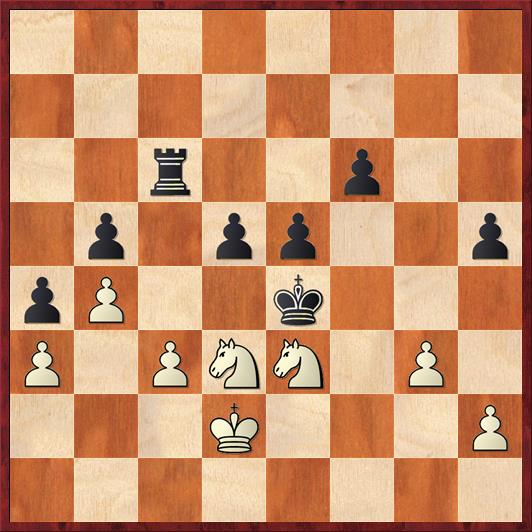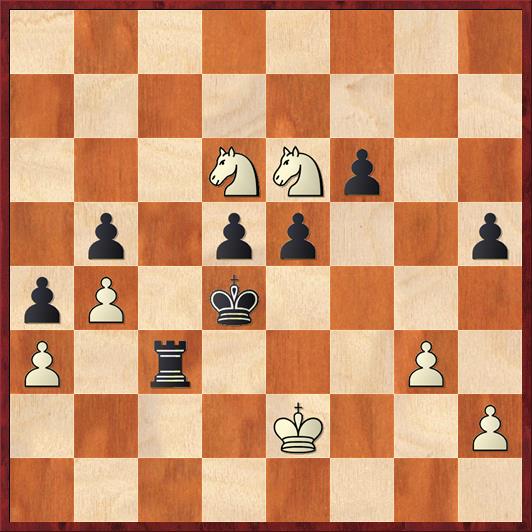With the San Francisco Mechanics not qualifying for the PRO Chess League playoffs, I didn’t watch the playoffs last night. It was my loss, because I missed the chance to watch in real time what one fan called “the best 60 seconds in PRO Chess League history” and what GM Robert Hess called “the most beautiful mate I’ve ever seen!”

FEN: 8/8/2r2p2/1p1pp2p/pP2k3/P1PNN1P1/3K3P/8 w – – 0 46
This position arose in the game between Zhao Jun of Chengdu (2612), playing White, and Razvan Preolu of Dallas (2513), playing Black. Preolu has just played 45. … Ke4??, which in hindsight was a catastrophic blunder. But at the time, it surely looked like a reasonable attempt to penetrate White’s kingside with … Kf3 or at least to force White into a deeply defensive position after 46. Ne1.
At this point Zhao had 22 seconds left to 19 seconds for Preolu. Zhao thought for 17.6 seconds on his move, and then uncorked the combination heard round the world.
(Space added to give you one last chance to find it!)
Zhao calmly played
46. Ke2!! …
I have always been a fan of combinations where the king plays an essential role. By taking away the flight square on f3, White threatens 47. Nf2 mate! Black has only one defense.
46. … Rxc3
In any normal position this would be the game-winning move for Black. This isn’t a normal position.
47. Nc5+ Kd4
Of course Black cannot play 47. … Rxc5 48. bc because the c-pawn would queen.
48. Ne6+ Ke4
49. Nc5+ Kd4
This little repetition of moves is fascinating from the psychological point of view. It tells me one of two things. Possibly White wanted to gain a couple seconds on his clock just so he could make sure of the checkmate. Alternatively, he may not have even seen the checkmate at first, and played 46. Ke2 with the intention of forcing a draw. But then he read my recent blog post about “brilliancy checks” – in which I wrote about a game I played against the computer where I was intending to play a threefold repetition but then saw that the computer evaluated the position as a 17-pawn advantage for me. That inspired me to look for something better than a draw, and I found the winning line.
Well, just kidding. I don’t think that Zhao Jun reads my blog. But it sure does look as if he did a brilliancy check here and found one for the ages.
50. Nf5+! Kc4
51. Nd6+ Kd4
It’s just incredibly cool how White’s knights control all the flight squares except c3, which is occupied by Black’s rook (which is looking rather embarrassed about it).
52. Ne6 mate!
I’ve got to show the final position.

FEN: 8/8/3NNp2/1p1pp2p/pP1k4/P1r3P1/4K2P/8 b – – 0 52
Coolest mate ever? Well, maybe not, because back in the nineteenth century they had some pretty cool ones. And you could argue that all checkmates are equally cool, because they all end the game with a victory.
Nevertheless, this one is quite special, first, for the way it came out of nowhere. It seemed as if White was just hanging on and hoping for a draw. And it’s also beautiful because of its symmetry, the way the knights take mirror-image paths d3-c5-d6 and e3-f5-d6. I am also impressed by its economy, weaving a mating net with nothing more than two knights and a king, which aren’t even supposed to be “mating material.”
It just goes to show that every day, somewhere on the Internet, somebody could be playing the greatest game you never saw.
By the way, Chengdu won the match against Dallas, 9 1/2 – 6 1/2. In the night’s other matches, Montclair tied St. Louis 8-8 but St. Louis advances based on a better regular-season record. Minnesota beat Australia, 8 1/2 – 7 1/2, and Webster beat New York 9-7, setting up a match next week (Webster vs. St. Louis) that is basically St. Louis versus St. Louis.



{ 2 comments… read them below or add one }
I’ve never seen another mate like this one I played in 1992. One of my better games.
Jeff Washburn (1802) – Splane 3-7-92
1. e4 e6 2. d3 c5 3. Nf3 Nc6 4. g3 d5 5. Bg2 de 6. de Qd1+ 7. Kd1 b6 8. Bf4 h6 9. h4 Bb7 10. c3 Nf6 11. Nbd2 Ng4 12. Ke1 e5 13. Be3 Ne3 14. fe Rd8 15. Nc4 b5 16. Na3 a6 17. Ke2 c4 18. Rhd1 Bd6 19. Rd2 Ke7 20. Nc2 Nb8 21. Nfe1 Nd7 22. a4 Nc5 23. ab ab 24. Ra7 Ra8 25. Ra8 Ra8 26. Nb4 Be4 27. Be4 Ne4 28. Rd5 Ng3+ 29. Kf3 Nf5 30. Ng2 Ra1 31. Rb5 Rf1+ 32. Kg4 h5+ 33. Kg5 Nh6 34. Nc6+ Ke6 35. Nf4+ ef 36. Nd4+ Kd7 37. ef Bf4+ 38. Kh5 g6 #
Another factor that adds to the aesthetics of this checkmate are the black pawns on e5 and d5. The knights appear oblivious to the black king in their neighborhood. Even though we all know knights do not respect pieces ‘in their way’ the pawns almost seem to form a protective wall shielding their king from the knights. In fact, of course, they merely serve to reduce the flight squares available to the king. It just does not look like much of an attack, much less a checkmate.
Thanks for sharing this!